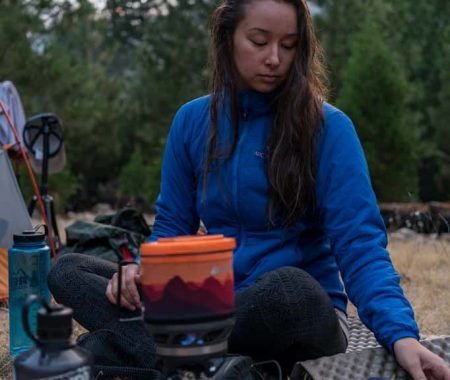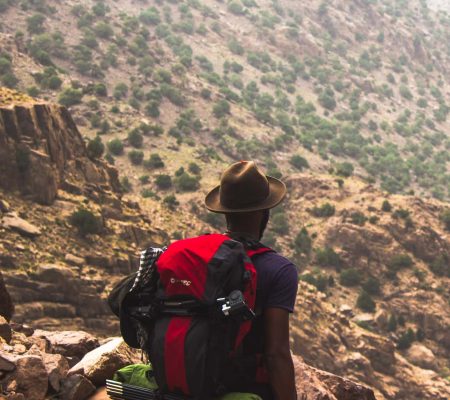Conscious Eating: 5 Tips on How to Pack for a Backcountry Trip
The recuperative and vitalizing effects of a backcountry trip adventure can often be observed within days of return. Muscles tighten in the legs and your core feels more intensely activated, while your mood becomes lighter and more composed. Indeed, this last trip has been absorbed into your body, every steep switchback etched into your heart and calf muscles. However, your body and mind can only grow in proportion to the nourishment you give them. Without proper nutrition, you aren’t getting as much out of your trips—you may in fact be stressing your body and causing it to deteriorate. Most high-level athletes follow comprehensive dietary programs. This is because they need to monitor their caloric intake closely, in order to compete effectively. Really, for anyone who wants to exercise, and especially for folks who want to do so in the backcountry, it’s vital to make a plan for nutrition.
For many people, the easiest and most direct way of bringing food on an overnight or day trip is to go with prepackaged solutions. These come in different forms; freeze dried bags of food, energy bars, gels, soup packets, noodles, granola, gummies, and other easy ways to get calories fast. These options typically have some benefits and some drawbacks. On the one hand, they are fast, lightweight, and hard to mess up. On the other hand, they can be insufficiently nutritive, expensive, and produce a lot of potential trash pollution if carried in individual wrappers.
These prepackaged solutions have their place on virtually any backcountry trip—they provide stopgap replenishment and security. It is always recommended for each backcountry traveler to have at least one emergency freeze dried meal stowed in the bottom of their pack. Most experienced travellers supplement these types of prepackaged nutrition with other solutions they come up with at home. This is a good way to not only save some money, but also have more autonomy over the kinds of foods you eat on your trip. You may find that it will also help increase the overall quality of the nutrition you receive, and brighten your mood and physical state in return.
Knowing how to pack food correctly for a trip or even a day hike is an art. Take too much, and you may burn out fast due to the extra weight. Take too little, and you may find yourself uncomfortably rationing calories near the end of the trip. Day hikers who pack too little food could experience the dreaded “bonk” in which your energy levels can drop precipitously after a few hours of intense activity without refilling the system. It’s best to always have some backup food, a few ounces feels like nothing on your back but can change the outlook of an emergency. Here’s a rough guide on the types of foodstuffs you should bring on your trips. Remember that every trip is different and may require certain adjustments. In general, the drier a destination is, the more dry (and lightweight) your food will need to be in order to offset the weight of extra water on your back. If you have any questions about what to bring on your next trip, consult your Recal outfitter’s guide on specific considerations for that area.
1. Bring enough of (the right) sugar
When you are in the middle of a hike or bike ride and need energy fast, consuming sugar is by far the most effective way to gain it. When compared to proteins and fats, sugars absorb into the bloodstream at a much faster rate. This means you can physically “feel” it much faster, allowing you to continue your activity unabated. All sugars are not the same however, and bad sources of sugar can cause muscular fatigue, heartburn, and dehydration. Still, it is okay to bring some candy bars for morale and super fast energy boosts. Just make sure that candy doesn’t form the backbone of your sugar intake. There are a wide variety of sugary energy bars sold to outdoors enthusiasts. These bars come in varying qualities. Instead of marketing, try to focus on the ingredients. Avoid refined cane sugar, wheat, carnauba wax, palm oil, and names of things that sound like they were created in a laboratory. Look for nutrient heavy ingredients in energy bars, unrefined sugars, dates, natural syrups, and fruits. Alongside energy bars, consider bringing other sources of sugar like dates, chocolate, dry fruits, and even fresh ones. Fresh fruits like apples and pears are high in phytonutrients, antioxidants, and help immensely more than any industrial solution for electrolytes.
2. Get your snacks nailed down
Sugars are great for keeping your energy high during the day, but they won’t leave you feeling full and satisfied. For that you need to figure out snacks that are rich in proteins, carbs, fats, and vitamins. These snacks will help sustain you, ward off muscle fatigue in the tent, and keep you feeling jolly. A great time-tested choice for daytime snacking is trail mix, which is usually a mix of nuts, chocolate, and dry fruits with many different combinations available. Trail mixes are available prepackaged, but in general you will be getting better quality nuts if you buy them separately and make your own mix. Walnuts, almonds, cashews, pumpkin seeds, and macadamia are all excellent choices. Avoid bringing a mix with only peanuts. Alongside that, consider bringing either pre-made sandwiches and wraps, or supplies for making them. Jerky and salami are options for meat eaters, although they may leave you feeling a bit more sluggish than less processed meats would. Sometimes simplicity is helpful. A plain avocado is awesome for long lasting energy and sustenance.
3. Consider supplements
Inevitably, on any multi-day trip you will be rehydrating food at some point. Technically, oatmeal is a dehydrated food. Let’s take a look at oatmeal, since it’s a very popular breakfast choice, and ways to supplement it. First thing to do would be to add in some sugars. Honey, dates, raisins, or unrefined sugars would be good choices here. Next thing to do is add fat. Here, nuts/seeds and nut/seed butters are a great option, alongside dried coconut, and oils (coconut, cacao). Finally, consider bringing some powdered supplements for your oatmeal. Cacao powder, maca, psyllium, and spirulina powder are all viable options. For supplementing savoury foods, try bringing things like dried mushrooms, hard cheese, smoked fish, sun dried tomatoes and more. The best way to figure out what supplements will work for you is to try many. You can find many good ones in bulk food sections of grocery stores, or in the cuisines of different cultures.
4. Be creative
The idea with conscious eating is to connect with your food. There is no strict dogma governing what you can and cannot bring into the backcountry, so you should experiment with what is possible. Oftentimes, local businesses and restaurants will have great options. A banh mi or a pizza in a plastic bag is wonderful at both filling the belly and boosting morale. Look for different packing solutions for your food. Some outdoor brands offer tubes for nut butters, collapsible tupperware, sealable cookware, and other such things. Think outside the box when it comes to dehydrated food—there are far more ways to bring it than in prepackaged baggies. Again, look to the bulk food section for this. Polenta is a classic base and thickener. Sometimes it’s okay to move away from dehydrated foods, especially on shorter trips. Try to push the limits of your backcountry cuisine, it’s usually an enjoyable experience. A backcountry pro can make a piping hot bread in the field using just flour, yeast, sugar, salt, water, a tin cup, and a campfire. Have it with some roasted meat or eggplant, and you’lll be feeling like a four-star hotel has nothing on your camping experience.
5. Hydrate
It’s already established that your body only strengthens in relation to the quality of nutrition you give it while on a trip. It’s important to note that furthermore, your body can only absorb nutrients well if you are properly hydrated. Try to drink water at regular intervals throughout the day, consuming a minimum of 3-4 liters daily depending on your body size. In dry climates and hot weather, that number will go up significantly. Don’t try to squeeze in hydration along with eating, take them separately whenever possible. Drinking water and eating in quick succession confuses your stomach and slows digestion. Instead, take sips of water at regular intervals and avoid the feeling of thirst altogether. Packing electrolyte mixes is a good idea, but they come in varying qualities. The sugariest and most industrial forms contain diuretic levels of sugar, so you should avoid them. Mandarin oranges work as a natural electrolyte hack. A handy trick from Traditional Chinese Medicine is to drink your water hot, as it aids digestion greatly. For this reason, a lightweight thermos is an excellent accessory for any backcountry traveller.
A Few Parting Words
There are no hard and fast rules for conscious eating. If you feel drawn towards or want to experiment with a particular diet, do it. There are merits to vegetarianism, veganism, gluten-free diets, and more. If you choose to eat meat, try and find less processed forms that have been smoked for preservation. Local ingredients are usually some of the best options for carrying with you. Remember that food is supposed to make you feel good, so trust your stomach and physical sensations over what others tell you. More expensive food does not always equal more delicious or healthier. Do your own research and investigation before choosing to buy a large quantity of something. Always make a plan for packing out all your trash, a plastic bag big enough to be tied shut will usually suffice. When washing dishes and disposing of food waste, always disperse dirty water in a large pattern far away from water sources. Try to minimize food waste in the backcountry, remember the “leave no trace” principles. Do not throw things like banana peels and olive pits into the woods, wild animals will often eat things that smell like food at their own peril. Food waste is generally safe to burn in a campfire, if you’re unable to pack it out. Pure dogmatism is often counterproductive, and it’s okay to have a mix of “healthy” and “unhealthy” food items in your pack. What matters most is that you experiment and evolve with your experiences. The rest comes with time.


